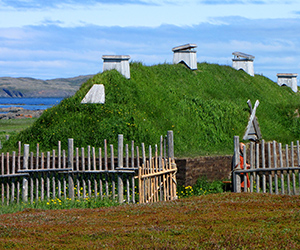CANADA HISTORY - Politics-Symbols
The Mace

The Mace in the Canadian Parliament is a powerful symbol of authority and tradition, deeply rooted in the history of parliamentary governance and the monarchy. Its presence in both the House of Commons and the Senate represents the power and authority of the Crown within Canada’s parliamentary system, serving as a constant reminder of the historical relationship between the monarchy and the democratic process. While the modern use of the Mace is ceremonial, its origins are much more pragmatic, evolving from a weapon of war into an iconic representation of parliamentary authority.
Historical Origins of the Mace
The Mace has a long and storied history, dating back to the medieval era. Originally, the Mace was a weapon used in combat, particularly during the age of knights and chivalry. The medieval Mace was a heavy, club-like weapon with a metal head, often studded with sharp blades or spikes. When wielded with force, it could crush armor and cause lethal damage to an opponent. As a weapon of war, it was highly effective in close combat, allowing the wielder to break through shields or the exposed parts of a victim’s body, causing grievous injury.
Over time, the Mace evolved beyond its role as a weapon of war and took on ceremonial and symbolic functions. As the monarchy and its governing institutions developed, the Mace became a symbol of authority, wielded by guards or officials in the service of the sovereign. In the early days of English parliamentary tradition, the Mace was carried by a representative of the monarch, typically a sergeant-at-arms, during formal proceedings. Its presence symbolized the monarch's authority over the proceedings, and no one else in the chamber was permitted to carry a weapon. This ceremonial function continues to this day, though its meaning and purpose have transformed to reflect the modern constitutional monarchy and parliamentary democracy.
The Mace in Canadian Parliamentary Tradition
In Canada, the Mace continues to represent the authority of the Crown in Parliament. Canada’s parliamentary system is modeled on the Westminster system, and the traditions surrounding the Mace are a direct inheritance from British parliamentary practices. In both the House of Commons and the Senate, the Mace is a vital part of parliamentary procedure, symbolizing the Crown’s role as the source of lawful authority in the legislative process.
The Mace is an ornate object, typically crafted from precious metals such as silver or gold and richly decorated with symbols of the Crown. The Mace used in the Canadian House of Commons, for example, features a crown on its head, representing the Queen or King, along with other intricate decorations reflecting the monarchy’s historical relationship with Canada. This ceremonial object is an enduring symbol of the link between the monarch and the legislature, representing the authority under which Parliament operates.
The Role of the Mace in Parliamentary Sessions
The Mace plays an essential role in the formal proceedings of both the House of Commons and the Senate. Before a session of Parliament can begin, the Mace must be present. Its placement and movement are steeped in tradition and reflect the authority it symbolizes.
At the opening of a session of the House of Commons or the Senate, the Mace is carried into the chamber by the Sergeant-at-Arms in a formal procession. The Sergeant-at-Arms, a senior official responsible for maintaining order and security within Parliament, carries the Mace on their shoulder as they follow the Speaker of the House into the chamber. The Speaker, as the presiding officer of the House, is the representative of the House to the Crown and Parliament, and the ceremonial entrance with the Mace signifies the formal commencement of parliamentary business.
Once the Speaker reaches the dais, the Sergeant-at-Arms places the Mace on the central table in front of the Speaker’s chair, with the crown of the Mace pointing towards the Speaker. The Mace remains on this table for the duration of the session. Its presence signifies that Parliament is legally in session and that the authority of the Crown is being exercised through the legislative body. Without the Mace, no parliamentary business can be conducted.
At the end of the session, the Mace is once again removed by the Sergeant-at-Arms, marking the formal conclusion of parliamentary proceedings for the day. The Mace's removal signals that the authority of the Crown, as exercised by Parliament, has been suspended until the next session.
The Mace and the Speech from the Throne
The ceremonial use of the Mace takes on a special significance during the Speech from the Throne, a key event that marks the opening of a new parliamentary session. The Speech from the Throne is delivered by the Governor General, who represents the monarch in Canada, and outlines the government’s legislative agenda for the upcoming session.
When the Governor General enters the House of Commons to deliver the speech, a unique tradition occurs: the Mace is covered with a velvet cloth. This symbolic act reflects the principle that the representative of the monarch cannot be in the presence of their own authority. By covering the Mace, Parliament temporarily conceals the symbol of the Crown's authority, showing that the Governor General, as the direct representative of the sovereign, holds the highest authority during the speech.
Once the Governor General has delivered the speech and leaves the chamber, the velvet cloth is removed from the Mace, and parliamentary proceedings can resume. This ritual highlights the careful balance between the ceremonial role of the monarchy and the functioning of a democratic legislature.
The Mace and the Election of a Speaker
A particularly important tradition involving the Mace occurs at the beginning of a new Parliament following a federal election. Until the House of Commons has elected a Speaker, the Mace is not placed on the central table. The absence of the Mace signifies that the House is incomplete and cannot conduct any business until a Speaker has been chosen.
Once the Speaker is elected by the members of the House, the Mace is brought forward and placed on the table. Its placement signifies that the House is now properly constituted and that the authority of the Crown is recognized in the chamber, allowing Parliament to proceed with its legislative duties. This tradition underscores the critical role of the Speaker as the mediator between Parliament and the Crown.
The Mace in the Senate
The Mace plays a similar role in the Senate of Canada, where it symbolizes the authority of the Crown in the upper house of Parliament. Like in the House of Commons, the Sergeant-at-Arms (or in the Senate, the Usher of the Black Rod) carries the Mace into the Senate chamber at the start of each session. The Mace is placed on a table in front of the Speaker of the Senate, and it remains there as long as the Senate is in session. Without the Mace, the Senate cannot legally conduct its business.
The Symbolic Power of the Mace
Though it no longer serves its original purpose as a weapon, the Mace continues to be a powerful symbol of authority, history, and tradition in Canada’s parliamentary system. It represents the authority of the Crown, but it also symbolizes the enduring relationship between the monarchy and Canada’s democratic institutions. The ceremonial use of the Mace reminds both legislators and the public of the historical roots of Canada’s parliamentary system, where power is exercised in the name of the Crown but under the authority of the people’s elected representatives.
The rituals surrounding the Mace, from its placement in the chamber to its covering during the Speech from the Throne, highlight the balance of power and tradition in Canada’s governance. While the monarchy remains a central symbol of authority, the democratic principles of representation, debate, and lawmaking are at the heart of Canada’s Parliament.
The Mace in the Canadian Parliament is far more than a ceremonial object. Its history, dating back to medieval times when it was used as a weapon of war, underscores its symbolic power as an instrument of authority. Today, the Mace represents the authority of the Crown in Canada’s constitutional monarchy and is a critical element in the operation of both the House of Commons and the Senate. Through its careful use in parliamentary proceedings, the Mace continues to serve as a reminder of Canada’s enduring traditions, the power of the monarchy, and the democratic principles that guide the nation’s governance.
Cite Article : Reference: www.canadahistory.com/sections/documents/documents.html
Source: NA



